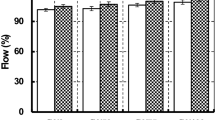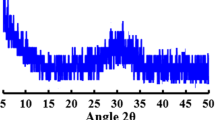Abstract
This study examines the use of natural seawater as mixing water for alkali-activated slag concrete and reports the characteristics of alkali-activated slag concrete with exposure to seawater. Preliminary experiments were conducted on pastes in order to measure pH and select optimum activator content under the experimental conditions. Wet-sieved pastes from fresh concrete were used to evaluate the mineralogical and microstructural characteristics of reaction products. Compressive strengths and chloride contents were measured with the hardened concrete samples. The activators used in alkali-activated slag concrete were sodium hydroxide (5% weight of slag) and liquid sodium silicate (5% weight of slag). The alkali-activated slag samples showed the carbonation of calcium silicate hydrate (C–S–H), which resulted in the reduction in strength with time. The seawater-mixed alkali-activated slag samples produced additional reaction products, C4AH13, and chloride-bearing hydrocalumite, and they improved the strength. The seawater-mixed alkali-activated slag samples exposed in seawater exhibited improved mechanical performance compared to other samples. C–S–H carbonation did not occur, refinement of the pore structure was confirmed, and the compressive strength increased after exposure to seawater. The release of partial chloride ions, which were bound in solid phases, occurred; however, such slight leaching did not affect the strength of the samples. The investigation within the experimental conditions of this study showed a positive result regarding the use of seawater as mixing water in alkali-activated slag concrete.










Similar content being viewed by others
References
Ghrair AM, Heath A, Paine K, Al Kronz M (2020) Waste wash-water recycling in ready mix concrete plants. Environ. https://doi.org/10.3390/environments7120108
Rain and Freshwater. World Meteorological Organization. https://public.wmo.int
Etxeberria M, Gonzalez-Corominas A, Pardo P (2016) Influence of seawater and blast furnace cement employment on recycled aggregate concretes’ properties. Constr Build Mater 115:496–505. https://doi.org/10.1016/j.conbuildmat.2016.04.064
Ghorab HY, Hilal MS, Antar A (1990) Effect of mixing and curing waters on the behaviour of cement pastes and concrete Part 2: Properties of cement paste and concrete. Cem Concr Res 20(1):69–72. https://doi.org/10.1016/0008-8846(90)90117-G
Shi Z, Shui Z, Li Q, Geng H (2015) Combined effect of metakaolin and sea water on performance and microstructures of concrete. Constr Build Mater 74:57–64. https://doi.org/10.1016/j.conbuildmat.2014.10.023
Katano K, Nobufumi T, Ishizeki Y, Iriya K (2013) Properties and application of concrete made with sea water and un-washed sea sand. In: 3rd Int Conf Sustain Constr Mater Tech, Kyoto, Japan
Otsuki N, Furuya D, Saito T, Tadokoro Y (2011) Possibility of sea water as mixing water in concrete. 36th Conf World Conc Struct 36:131–138
Mbadike EM, Elinwa AU (2011) Effect of salt water in the production of concrete. Niger J Tech 30(2):105–110
Kaushik SK, Islam S (1995) Suitability of sea water for mixing structural concrete exposed to a marine environment. Cem Concr Compos 17(3):177–185. https://doi.org/10.1016/0958-9465(95)00015-5
Wegian FM (2010) Effect of seawater for mixing and curing on structural concrete. IES J Part A: Civ Struct Eng 3(4):235–243
Younis A, Ebead U, Suraneni P, Nanni A (2018) Fresh and hardened properties of seawater-mixed concrete. Constr Build Mater 190:276–286. https://doi.org/10.1016/j.conbuildmat.2018.09.126
Ozaki S, Sugata N (1988) Sixty-year-old concrete in a marine environment. ACI Spec Publ 109:587–598
Nishida T, Otsuki N, Ohara H, Garba-Say ZM, Nagata T (2013) Some considerations for the applicability of seawater as mixing water in concrete. In: 3rd Int Conf Sustain Constr Mater Tech, Kyoto, Japan
Collins FG, Sanjayan JG (1999) Workability and mechanical properties of alkali activated slag concrete. Cem Concr Res 29(3):455–458. https://doi.org/10.1016/S0008-8846(98)00236-1
Bakharev T, Sanjayan JG, Cheng YB (2001) Resistance of alkali-activated slag concrete to carbonation. Cem Concr Res 31(9):1277–1283. https://doi.org/10.1016/S0008-8846(01)00574-9
Aydın S, Baradan B (2012) Mechanical and microstructural properties of heat cured alkali-activated slag mortars. Mater Des 35:374–383. https://doi.org/10.1016/j.matdes.2011.10.005
Provis JL, Bernal SA (2014) Geopolymers and related alkali-activated materials. Annu Rev Mater Res 44:299–327. https://doi.org/10.1146/annurev-matsci-070813-113515
Khan MSH, Kayali O, Troitzsch U (2016) Chloride binding capacity of hydrotalcite and the competition with carbonates in ground granulated blast furnace slag concrete. Mater Struct 49(11):4609–4619. https://doi.org/10.1617/s11527-016-0810-z
Jun Y, Yoon S, Oh JE (2017) A comparison study for chloride-binding capacity between alkali-activated fly ash and slag in the use of seawater. Appl Sci 7(10):971. https://doi.org/10.3390/app7100971
ASTM C305–14 (2014) Standard practice for mechanical mixing of hydraulic cement pastes and mortars of plastic consistency. ASTM International, West Conshohocken, PA
Park H, Jeong Y, Jeong J-H, Oh JE (2016) Strength development and hydration behavior of self-activation of commercial ground granulated blast-furnace slag mixed with purified water. Mater 9(3):185. https://doi.org/10.3390/ma9030185
Tashima MM, Akasaki JL, Melges JLP, Soriano L, Monzó J, Payá J, Borrachero MV (2013) Alkali activated materials based on fluid catalytic cracking catalyst residue (FCC): Influence of SiO2/Na2O and H2O/FCC ratio on mechanical strength and microstructure. Fuel 108:833–839. https://doi.org/10.1016/j.fuel.2013.02.052
ASTM C192/C192M-19 (2019) Standard practice for making and curing concrete test specimens in the laboratory. ASTM International, West Conshohocken, PA
ASTM C39/C39M-20 (2020) Standard test method for compressive strength of cylindrical concrete specimens. ASTM International, West Conshohocken, PA
ASTM C1152/C1152M-04 (2012) Standard test method for acid-soluble chloride in mortar and concrete. ASTM International, West Conshohocken, PA
ASTM C1218/C1218M-17 (2017) Standard test method for water-soluble chloride in mortar and concrete. ASTM International, West Conshohocken, PA
Chindaprasirt P, Chalee W (2014) Effect of sodium hydroxide concentration on chloride penetration and steel corrosion of fly ash-based geopolymer concrete under marine site. Constr Build Mater 63:303–310. https://doi.org/10.1016/j.conbuildmat.2014.04.010
Arya C, Buenfeld NR, Newman JB (1990) Factors influencing chloride-binding in concrete. Cem Concr Res 20:291–300. https://doi.org/10.1016/0008-8846(90)90083-A
Cheewaket T, Jaturapitakkul C, Chalee W (2010) Long term performance of chloride binding capacity in fly ash concrete in a marine environment. Constr Build Mater 24(8):1352–1357. https://doi.org/10.1016/j.conbuildmat.2009.12.039
PDF-2 Database (2000). In: Data ICDD, editor, Newtown Square, PA
Allmann R, Hinek R (2007) The introduction of structrue types into the inorganic crystal structure database ICSD. Acta Crystallogr A 63(5):412–417
Song S, Sohn D, Jennings HM, Mason TO (2000) Hydration of alkali-activated ground granulated blast furnace slag. J Mater Sci 35(1):249–257. https://doi.org/10.1023/A:1004742027117
Song S, Jennings HM (1999) Pore solution chemistry of alkali-activated ground granulated blast-furnace slag1. Cem Concr Res 29(2):159–170. https://doi.org/10.1016/S0008-8846(98)00212-9
Huanhai Z, Xuequan W, Zhongzi X, Mingshu T (1993) Kinetic study on hydration of alkali-activated slag. Cem Concr Res 23(6):1253–1258. https://doi.org/10.1016/0008-8846(93)90062-E
Li C, Sun H, Li L (2010) A review: The comparison between alkali-activated slag (Si+Ca) and metakaolin (Si+Al) cements. Cem Concr Res 40(9):1341–1349. https://doi.org/10.1016/j.cemconres.2010.03.020
Ben Haha M, Le Saout G, Winnefeld F, Lothenbach B (2011) Influence of activator type on hydration kinetics, hydrate assemblage and microstructural development of alkali activated blast-furnace slags. Cem Concr Res 41(3):301–310. https://doi.org/10.1016/j.cemconres.2010.11.016
Lin K-L, Hwang C-L, Shie J-L, Chang Y-M, Cheng A (2014) Hydration characteristics of waste catalysts used as pozzolanic materials. Environ Prog Sustain Energy 33(2):353–358. https://doi.org/10.1002/ep.11782
Yuan Q, Shi C, De Schutter G, Audenaert K, Deng D (2009) Chloride binding of cement-based materials subjected to external chloride environment–A review. Constr Build Mater 23(1):1–13. https://doi.org/10.1016/j.conbuildmat.2008.02.004
Grover K, Komarneni S, Katsuki H (2010) Synthetic hydrotalcite-type and hydrocalumite-type layered double hydroxides for arsenate uptake. Appl Clay Sci 48(4):631–637. https://doi.org/10.1016/j.clay.2010.03.017
Wang SD, Scrivener KL (1995) Hydration products of alkali activated slag cement. Cem Concr Res 25(3):561–571. https://doi.org/10.1016/0008-8846(95)00045-E
Kuwahara Y, Ohmichi T, Kamegawa T, Mori K, Yamashita H (2010) A novel conversion process for waste slag: synthesis of a hydrotalcite-like compound and zeolite from blast furnace slag and evaluation of adsorption capacities. J Mater Chem 20(24):5052–5062. https://doi.org/10.1039/C0JM00518E
Collins F, Sanjayan JG (2001) Microcracking and strength development of alkali activated slag concrete. Cem Concr Compos 23(4):345–352. https://doi.org/10.1016/S0958-9465(01)00003-8
Collins F, Sanjayan JG (1999) Strength and shrinkage properties of alkali-activated slag concrete containing porous coarse aggregate. Cem Concr Res 29(4):607–610. https://doi.org/10.1016/S0008-8846(98)00203-8
Mehta PK, Monteiro PJM (2006) Concrete: Microstructure, Properties, and Materials. McGraw-Hill, New York
Palacios M, Puertas F (2006) Effect of Carbonation on Alkali-Activated Slag Paste. J Am Ceram Soc 89(10):3211–3221. https://doi.org/10.1111/j.1551-2916.2006.01214.x
Zhuravlev LT (2000) The surface chemistry of amorphous silica Zhuravlev model. Colloid Surf A-Physicochem Eng Asp 173(1):1–38
Jambunathan N, Sanjayan JG, Pan Z, Li G, Liu Y, Korayem AH, Duan WH, Collins F (2013) The role of alumina on performance of alkali-activated slag paste exposed to 50 °C. Cem Concr Res 54:143–150. https://doi.org/10.1016/j.cemconres.2013.09.009
Schneider J, Cincotto MA, Panepucci H (2001) 29Si and 27Al high-resolution NMR characterization of calcium silicate hydrate phases in activated blast-furnace slag pastes. Cem Concr Res 31(7):993–1001. https://doi.org/10.1016/S0008-8846(01)00530-0
Jun Y, Kim T, Kim JH (2020) Chloride-bearing characteristics of alkali-activated slag mixed with seawater: Effect of different salinity levels. Cem Concr Compos. https://doi.org/10.1016/j.cemconcomp.2020.103680
Yahya Z, Abdullah MMAB, Jing LY, Li L-Y, Razak RA (2020) Seawater exposure effect on fly ash based geopolymer concrete with inclusion of steel fiber. IOP Conf Ser: Mater Sci Eng. https://doi.org/10.1088/1757-899X/743/1/012013
El-Didamony H, Amer AA, Abd Ela-ziz H (2012) Properties and durability of alkali-activated slag pastes immersed in sea water. Ceram Int 38(5):3773–3780. https://doi.org/10.1016/j.ceramint.2012.01.024
Acknowledgements
This research was supported by the Basic Science Research Program through the National Research Foundation of Korea (NRF) funded by the Ministry of Education (NRF-2020R1I1A1A01072504).
Author information
Authors and Affiliations
Corresponding author
Ethics declarations
Conflict of interest
The authors declare no conflict of interest.
Additional information
Publisher's Note
Springer Nature remains neutral with regard to jurisdictional claims in published maps and institutional affiliations.
Rights and permissions
About this article
Cite this article
Jun, Y., Kim, J.H., Han, S.H. et al. Influence of seawater on alkali-activated slag concrete. Mater Struct 54, 121 (2021). https://doi.org/10.1617/s11527-021-01719-5
Received:
Accepted:
Published:
DOI: https://doi.org/10.1617/s11527-021-01719-5




